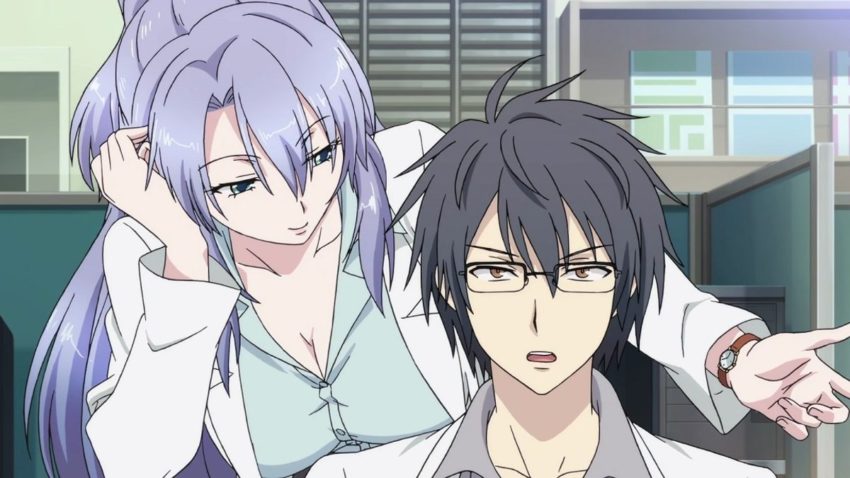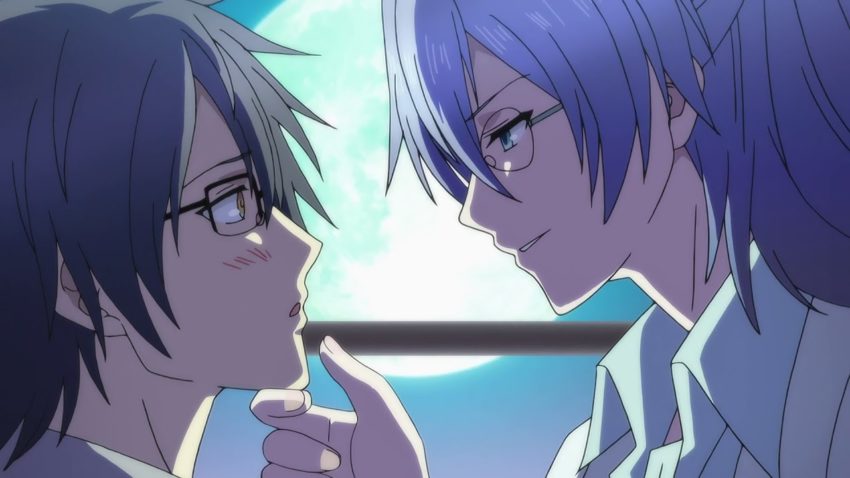By Amelia Prepare dinner.

Science Fell in Love, So I Tried to Show It is a comedy about two intense postgraduate college students who develop emotions for one another of their analysis lab. Earlier than the primary set of opening credit, elegant and assured Himuro states her emotions for her aloof mental rival, Yukimura. He’s surprised, and expresses cautious curiosity, however isn’t certain his emotions are love. “What’s the definition of ‘love’?” he asks. “Himuro, upon what proof did you establish that you just love me?”
You’d count on Himuro to be upset, however she isn’t. Quite the opposite, she is delighted by his problem, and presents a radical argument, with pie-charts, graphs, and a working speculation. On this scene and past, the sequence turns right into a unbelievable illustration and allegory for the expertise of on-line relationship. Simply not actually.

For a begin, it really works on the identical premise and processes as a relationship app. After Himuro’s presentation, she and Yukimura consider her argument, regulate the speculation, and decide a brand new analysis venture: to ascertain the ‘base situations’ of affection, the indicators that anybody in love is assured to expertise. They intend to make use of these to assemble a Turing machine that may reply the query “Is that this love a 0 or a 1?”
In different phrases, scientists are trying to find the suitable numbers to precisely assess the viability of a romantic relationship earlier than it begins. That’s the premise of Science Fell in Love and each relationship app on the market from eHarmony to OK Cupid. “Romantic affection, and the query of its willpower, might be rendered as a method.”
Ask a query, and make an informed guess at what the reply might be. Take a look at your guess, study from the outcomes, repeat. That’s the scientific methodology in a nutshell, which drives Himuro and Yukimura’s analysis, and their relationship. On-line relationship apps don’t use information from wearables like good watches (but). However whoever is advocating for it behind the scenes might effectively sound like Yukimura: “If we monitor coronary heart charge, we are able to quantitatively measure ‘thrilling palpitations of affection’.”

Digital relationship entrepreneurs have labored this manner for years. Again in 2014, in an OK Cupid weblog publish titled ‘We Experiment on People!’, co-founder Christian Rudder stated: “In the event you use the Web, you’re the topic of lots of of experiments at any given time, on each website. That’s how web sites work.” And if you wish to inform a narrative about an internet-based business with out truly exhibiting laptop scientists at work, laptop scientists in a lab are a wise side-step. Scientists like Himuro and Yukimura are a very good selection. Empirical to a fault, their insistence on prizing logic over emotion helps approximate on-line relationship dynamics of their 100% offline relationship.
When full strangers agree by text-message that they see the potential to sleep collectively/get married/elevate kids, it provides a shot of intimacy to their in any other case distant relationship, with nothing in between. Due to this, {couples} who match on-line have a distinct dynamic on their first date than {couples} who crushed on one another in individual, or who present as much as a blind date.
Science Fell in Love parallels this dynamic by swapping interpersonal unfamiliarity for further emotional distance, gag-manga fashion. A technique it does that is by inverting the web relationship mentality. Many individuals come to on-line relationship with a purchasing listing, desiring to take no dangers till they discover somebody who meets a prolonged guidelines of situations. Nonetheless, Himuro and Yukimura intend to take no dangers till they discover a prolonged guidelines of situations to justify their current curiosity. In each circumstances, the aim is to maintain attraction at arms’ size till the info strains up.

The present additionally inverts particular on-line relationship experiences. For instance, when Himuro states her emotions for Yukimura, each are sitting with their backs to one another, gazing laptop screens whereas they discuss. The place app customers might play it cool in DMs and freak out in actual life, Himuro and Yukimura communicate calmly whereas their typing dissolves into gibberish.
Himuro and Yukimura are naturally indifferent characters who discover a strategy to flip romantic exploration into their job. Every aspires to “all the time take care of issues calmly and intellectually.” So, their option to discover their emotions via a lab-wide analysis venture reasonably than, say, dinner and a film, truly downgrades their intimacy from comfy rivals to awkward new colleagues.
Whereas the experiments they run do carry them nearer, they steadily interrupt that closeness to document observations, or doom it from the beginning by prioritising effectivity. They convey extra as collaborating researchers than potential companions, hiding their wishes and fears behind medical evaluation and tutorial theories. All this further distance largely mitigates the affect of their pre-existing relationship on their romantic prospects. Due to this, their relationship develops extra like a pair who met on-line than a office romance.

If Science Fell in Love have been about two individuals who met via an app, you wouldn’t want to vary a lot about their relationship. Think about:
Determine 1: After their environment friendly and matter-of-fact expression of mutual curiosity, Himuro and Yukimura prepare conferences the place they will act out completely different relationship behaviours. They analyse their actions and reactions in depth to evaluate their romantic potential.
Determine 2: Each discover it laborious to belief their very own instincts, as an alternative counting on what the info says. Because of this, every new piece of data has a disproportionate affect on their very own opinions of their romantic potential.
Determine 3: When a sentiment is tough to voice, each use text-based communication as an alternative. At one level, they even arrange a strategy to precisely document their feelings in direction of one another via one faucet on their cellphone screens.
In the event you’ve ever tried on-line relationship, a few of this may increasingly sound acquainted.

Himuro and Yukimura’s first on-screen interplay is strictly one minute of verbal sparring adopted by Himuro telling Yukimura that she has emotions for him. The beginning of many happily-ever-afters within the web age. A far cry from the longing glances and dramatic confessions extra typical of anime romance.
The 2 of them hardly ever discuss with their time collectively earlier than the sequence, and by no means intimately. From the viewers’s perspective, their relationship begins with the equal of twelve messages and an expression of mutual curiosity that transforms their earlier dynamic. It’s some of the environment friendly begins to a requited romance in anime, that includes two of the obvious candidates for on-line relationship.
With some anime {couples}, you need to surprise how appropriate they really are. Are they happier collectively than they’d be with anybody else, or simply childhood sweethearts who consider in destiny? What fuels their relationship: is it real love, or the traumatic occasion they went via collectively in season one? Not so in Science Fell in Love. As an alternative, you need to surprise if both of those folks may ever make a romantic relationship work with anybody else. Himuro and Yukimura’s language is science. Interrupting a hug to assessment their respective coronary heart charges may look unromantic, however they take pleasure in these experiments of their entirety. They’re by no means happier or extra attracted to one another than when changing a real-world downside into equations they will clear up.
This intense devotion to rigorous evaluation places off different love pursuits and makes progress sluggish. Nevertheless it’s additionally precisely what attracts Himuro and Yukimura collectively and offers their relationship a hearth no-one else understands.

They’re uncommon. The best way they impart is uncommon, the actions they take pleasure in most are uncommon, and the way in which they strategy romance is uncommon. From what we see of their backgrounds, this has all the time been the case, and has usually remoted them from their friends. Area of interest on-line relationship is ideal for folks like this, social outsiders on the identical wavelength. Himuro and Yukimura’s relationship reveals what on-line relationship can obtain at its greatest.
And anime is the very best medium to painting on-line relationship. One of many largest challenges for any on-line relationship sequence is that text-based interactions are boring to observe. Most of us perceive now that on-screen ‘hacking’ appears to be like nothing like the actual factor. However that conference was set earlier than many individuals knew what the actual factor seemed like. Everybody is aware of what on-line relationship appears to be like like, warts and all, whether or not they’ve used it or not. At its worst, you’re seeing dick pics and getting ghosted. At its greatest, you’re chatting fortunately in DMs. How do you make that look attention-grabbing, not to mention romantic?
Web romance is a steamy sub-genre in novels however hardly ever the central subject of any TV present or movie, in Japan or in any other case. Anime has the very best shot of constructing on-line relationship into an aesthetically pleasing story although. Probably the most unimaginative strategy to present text-based interactions is thru close-ups of screens, typing fingers, shifting eyes, studying out loud. Anime takes this selection usually. However on the opposite finish of the spectrum, you will have the overlapping speech bubbles within the superflat Summer season Wars netscape.

Between these two extremes is a variety of much less artistic however nonetheless visually attention-grabbing choices. The plain choice is to have characters work together within the type of on-line avatars, however Science Fell in Love takes one other tack, illustrating Himuro and Yukimura’s communication with energetic equations, graphs, and charts. Simply as usually, although, it cuts to manga panels, sumo wrestlers, traditional anime, fairy tales, relationship sims, sports activities, laptop animations, stick figures, and different aesthetics. It’s vibrant and interesting, bringing dry information factors to life.
However why is on-line relationship all however absent from anime? The primary purpose is easy: stigma.
In 2018 YouTuber That Japanese Man Yuta hit the streets of Tokyo to ask younger passers-by if that they had heard of Tinder. Most hadn’t, although one recalled it being “some type of app for speaking with foreigners.” When requested about different relationship apps, most had no expertise or curiosity, assuming the accounts can be faux or that they’d be swindled out of cash.
The earliest relationship web sites in Japan, referred to as deai-kei (actually ‘encounter’) websites, rapidly grew to become infamous for crimes like fraud and solicitation. The consequence was a stigma round on-line relationship that’s taken 20 years, a technology of Fb use, and a pandemic lockdown to show the tide.
Fortunately for on-line relationship firms, the emergence of the phrase konkatsu in 2007 opened the door for a rebranding. Konkatsu is a time period to explain the lively seek for a companion to marry. For Japanese singles in 2007, konkatsu principally referred to actions like asking a good friend to introduce them to new folks or attending goukon (group dates), each nonetheless standard choices. However the relationship business noticed a chance. Inside two years there was a ‘konkatsu increase’ of economic companies to facilitate the seek for a partner. These days, konkatsu companies (and renkatsu companies, to assist a seek for love with out the deal with marriage) kind a posh ecosystem of matchmaking businesses, reside occasions, and on-line actions.

Relationship apps and web sites are usually not solely a part of this ecosystem, however legitimised by it. As a result of konkatsu is seen as one answer to Japan’s dangerously low delivery charge, there’s numerous institutional help for it. That help has grow to be increasingly digital, particularly for the reason that world pandemic has concurrently worsened the birth-rate disaster and made it tougher to satisfy new folks by likelihood.
Native officers facilitate machikon, city-wide matchmaking occasions, now additionally on-line. The Japanese authorities owns round 25 matchmaking businesses, and in 2020 introduced funding to subsidise AI upgrades for these businesses. Some firms even pay for relationship app memberships as an worker profit. Being on this class makes on-line relationship extra respectable and reliable.
Not everybody in Japan does konkatsu, in fact. Nevertheless it’s not a tiny area of interest, both. Of the individuals who bought married in Japan in 2019, it’s reported that 30% had been utilizing konkatsu companies. Many extra have used konkatsu companies – together with on-line – for enjoyable, buddies, and FOMO. Japan’s relationship panorama is stuffed with diversified relationship sorts, relationship instruments, and motivations for locating a companion.

However anime reveals virtually none of that variation, as a result of romance anime are virtually all primarily based in fantasy. Some romance anime are primarily based within the fantasy style, involving supernatural beings, magical powers, and different worlds are widespread. Some present extra mundane fantasies, like childhood guarantees, international settings, or harem households. Most frequently although, the fantasy is nostalgia, set in historic intervals or – the large one – teenage years. Lookup any anime romance listicle, take away anybody younger sufficient to be in highschool, and see what’s left.
That is the second purpose on-line relationship is so uncommon in anime: the business’s bias in direction of youth. Romances between human adults in anime set in up to date, actual world Japan are uncommon. Even then, most of these adults are college age, not prepared for the konkatsu that makes on-line relationship respectable. Certain, it’s unreasonable to count on anyone medium to characterize a complete nation’s romantic panorama. Nevertheless it’s putting how little of that panorama anime covers in comparison with Japanese TV, movies, novels, and manga.
In anime, adults most frequently fall in love via schooling, house-share, or shared passions. Nothing unsuitable with that, in fact. However there are such a lot of extra relationship origin tales that different Japanese media discover and anime doesn’t contact. In 2020 alone, Japanese TV dramas confirmed adults falling in love via all the above, plus omiai (a proper matchmaking introduction), quickie marriage, relationship apps, authorities matchmakers, social media, even social distancing at residence! They confirmed romance between outdated folks, queer folks, a global couple with kids… And 2020 wasn’t particular.
Manga and novels provide much more various tales, a few of which grow to be boundary-pushing sequence like 38sai Batsuichi Dokushin Onna ga Matching Apuri wo Yattemita Kekka Nikki (The Outcomes Diary of a 38-Yr-Outdated, Divorced, Single Girl Who Tried Relationship Apps). Whereas the title makes it sound like a gentle novel, it’s truly a memoir, primarily based on the true story of a Tokyo resident having fun with her single life with youthful males and celebrities. Anime simply doesn’t faucet into the identical vary of potential choices.
Often a sequence will add some nuance. In 2017, mid-career professionals met in a digital house in Restoration of an MMO Junkie… however the house was an MMORPG, and didn’t carry them collectively in actual life. In 2020, Lease-a-Girlfriend had undergrad college students assembly via an app… however as escort and consumer, slotting into outdated deai-kei associations. Whereas serials like this add welcome selection, they’re few and much between. There may be one outlier going above and past to steadiness the scales, although, and that’s Aggretsuko.

Major character Retsuko, an organization accountant in her mid-twenties, develops crushes and enters romantic relationships as you’ll count on. However she additionally dabbles in konkatsu, regardless of not eager to get married but, attending an omiai, goukon, and ‘omiai get together’ (pace relationship for marriage prospects). On prime of this, Aggretsuko has to this point showcased a feminine worker quitting work when she bought married, a divorcee with no real interest in remarriage, a lady in her forties investing in konkatsu, a working mom, and extra. It’s refreshing for an anime to offer a lot consideration to grownup ladies navigating relationship, love, and marriage.
With one notable exception: on-line relationship. Season three of Aggretsuko does introduce a relationship app… as a prototype for a personality’s facet hustle. No character at any level makes use of the app with the intention to discover a date with it. Aggretsuko incorporates a VR boyfriend who places you in debt via microtransactions, however doesn’t need to take care of on-line relationship.
And that is the third purpose on-line relationship doesn’t present up in anime: as a result of anime doesn’t usually characterize stigmatised industries actually. Take love inns. In Japan, their pay-by-the-hour rooms entice three major demographics: intercourse employees, folks having affairs, and eager younger {couples}. In anime (that isn’t hentai, which is a separate style with its personal conventions), they’re principally a spot to shelter (Weathering with You) or to kill time (Beastars). They grow to be websites of security or comedy, typically even sexuality. Intercourse work? Infidelity? Not a lot.

In gentle of all that, Science Fell in Love, So I Tried to Show It efficiently packages the really feel of on-line relationship to make it each extra acceptable for Japanese audiences and pleasing to romance followers anticipating characters to fall in love organically. It has the identical premise as a relationship app, and follows the identical processes. The characters are extremely appropriate misfits, the sort on-line relationship excels at bringing collectively. They work together in a method that brings on-line relationship hallmarks like a fast begin, emotional distance, and over-analysis into their relationship. The romance progresses in an identical strategy to relationships that begin on-line.
As for on-line relationship in the actual world, the business in Japan grew by 23% in 2020, and is predicted to greater than double that development within the subsequent 5 years. The pandemic has additional tanked Japan’s marriage charge and compelled extra conventional matchmaking companies on-line, the place they’re thriving. For the primary time ever, on-line relationship is about to be large in Japan – and anime is the right medium to characterize it, as a result of anime creators aren’t chained to the literal.
Amelia Prepare dinner is the founding father of Anime Feminist. Science Fell in Love, So I Tried to Show It is launched within the UK by Anime Restricted.